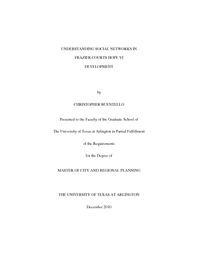
ATTENTION: The works hosted here are being migrated to a new repository that will consolidate resources, improve discoverability, and better show UTA's research impact on the global community. We will update authors as the migration progresses. Please see MavMatrix for more information.
Show simple item record
| dc.contributor.author | Buentello, Christopher | en_US |
| dc.date.accessioned | 2011-03-03T21:52:49Z | |
| dc.date.available | 2011-03-03T21:52:49Z | |
| dc.date.issued | 2011-03-03 | |
| dc.date.submitted | January 2010 | en_US |
| dc.identifier.other | DISS-11028 | en_US |
| dc.identifier.uri | http://hdl.handle.net/10106/5494 | |
| dc.description.abstract | The HOPE VI program enacted in 1992 represented a shift in public housing by addressing resident's needs through physical design improvements, self-sufficiency programs, and the deconcentration of poverty. Funding through HOPE VI allowed local housing authorities to demolish deteriorated public housing units and replace them with new income-inclusive housing units. The "hope" would be that low income residents would interact with middle income residents to access resources that are normally beyond the reach of low income individuals. This assumes of course that residents will interact amongst each other. Therefore, I conducted a survey of residents at Dallas' Frazier Courts to understand the type and utilization of social interaction within the development. Unfortunately, the results indicated that there is little or no interaction among residents and concerns with safety and management of the development itself. | en_US |
| dc.description.sponsorship | Grodach, Carl | en_US |
| dc.language.iso | en | en_US |
| dc.publisher | Urban & Public Affairs | en_US |
| dc.title | Understanding Social Networks In Frazier Courts HOPE VI Development | en_US |
| dc.type | M.C.R.P. | en_US |
| dc.contributor.committeeChair | Grodach, Carl | en_US |
| dc.degree.department | Urban & Public Affairs | en_US |
| dc.degree.discipline | Urban & Public Affairs | en_US |
| dc.degree.grantor | University of Texas at Arlington | en_US |
| dc.degree.level | masters | en_US |
| dc.degree.name | M.C.R.P. | en_US |
Files in this item
- Name:
- Buentello_uta_2502M_11028.pdf
- Size:
- 789.2Kb
- Format:
- PDF
This item appears in the following Collection(s)
Show simple item record


